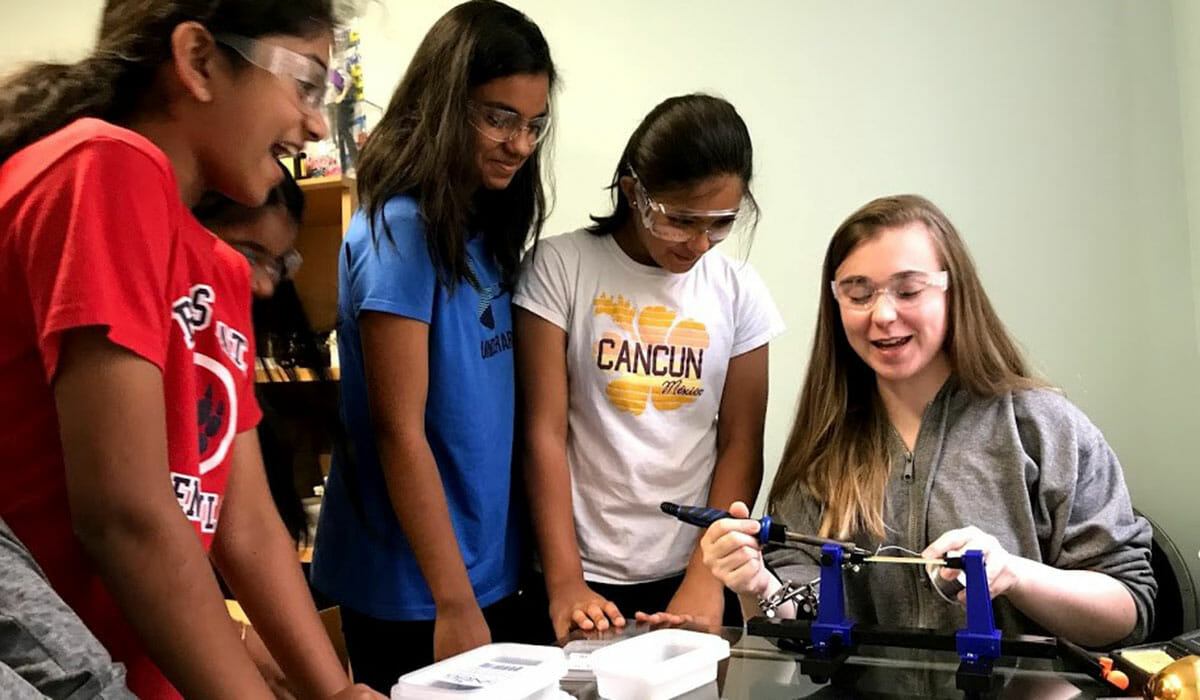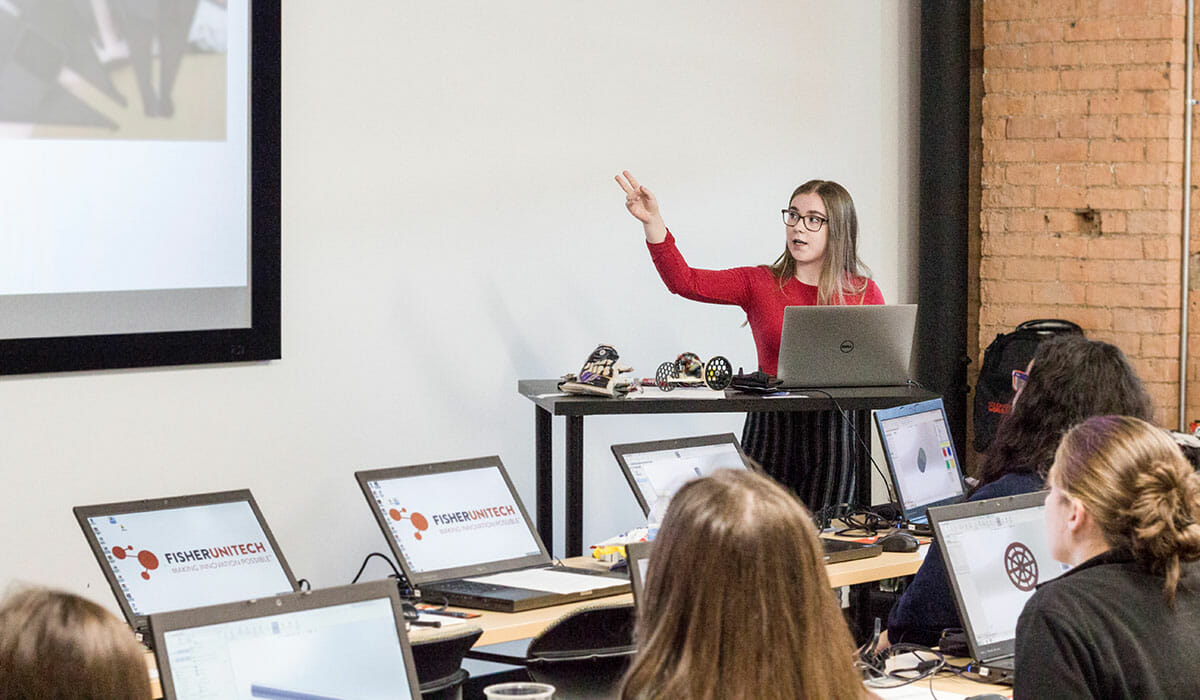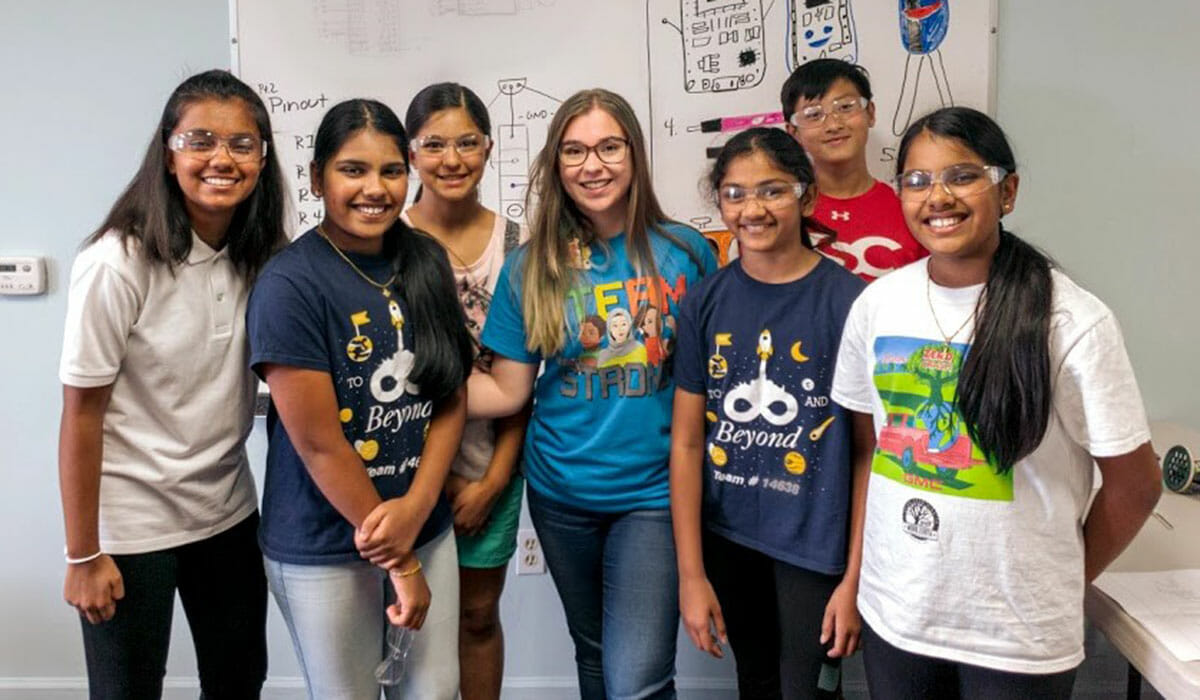Teen Creates Nonprofit to Provide Accessible and Affordable STEAM Education to Kids

Meet Daily Point of Light Award honoree Danielle Boyer. Read her story and nominate an outstanding volunteer or family as a Daily Point of Light.
Danielle Boyer has taken her passion for STEAM education and robotics far beyond her own classroom and personal studies. At just eighteen, she founded The STEAM Connection this past January in order to provide accessible and affordable science, technology, engineering, art and math educational resources to kids ranging from kindergarteners to high school seniors in her Michigan area who would not have the best educational opportunities in those academic areas otherwise. To do so, she invented her own robot for only $18.95 that she has given to over 700 kids in the past year to take home and continue working on. She also self-published five STEAM educational books filled with depictions of diverse characters who are not normally seen in textbooks. Through The STEAM Connection, Danielle mentors 35 robotics teams, holds school lectures, hosts events, runs a blog to connect the international STEAM community, and distributes her robots and books to children all over, including at children’s hospitals.
Now studying both mechanical and electrical engineering at Wayne State University, Danielle hopes to build a career focused in robotics. She also wants to continue expanding The STEAM Connection, and hopes that by the time she’s in graduate school, she will have opened up a couple of STEAM labs where kids all around the United States can go to assemble robots.
“I really want to make this organization bigger and bigger so kids will continue having access to reduces that they may not even have had access or knowledge about before,” Danielle said.
Describe your volunteer role with The STEAM Connection.
I founded the STEAM Connection earlier this year. I wanted to provide more accessible and affordable science, technology, engineering, art and math educational resources for kids. I was really upset because I see a lot of kids not being able to learn about robotics, not being able to learn about engineering, not having access to good education materials because of how expensive everything is and that really stressed me out. Seeing that the STEAM educational world favored those with a lot of money bummed me out. I started out with inventing my own robot, named Every Kid Gets A Robot. It costs $18.95 and it’s gone to over 700 kids this year which is awesome. It allows kids to learn about everything from mechanical engineering, to electrical engineering, to computer science, in an affordable way. I also self-published five science, technology, art, engineering and math books because I wanted kids to be able to see examples of themselves, so very diverse characters learning and doing things in STEAM education — learning about the environment, doing math, programming, making robots, doing science experiments, all that kind of stuff. Those have gone to over seven countries which is amazing. I have a really great team of high school students, like one, Dakshesh [Daruri]. He is on our team and he helps with media and I have some college students on my team as well. It’s really awesome because we’re all students and we put on events, we put on classes. I think in the past year and a half of I’ve put on over 45 events and classes mostly by myself, which is crazy. I also distribute robots and books as well.
What gave you the idea to start The STEAM Connection?
I’ve been in STEAM education since I was 10. I was homeschooled up until into my sophomore year of high school and at my homeschool group as a child, we didn’t have a lot of leadership options as kids. I begged my parents to let me teach an animal science class and shockingly they let me. I created my own curriculum, I created lessons, I fed them way too much sugar, and from there on out I realized I really have a passion for STEAM education and engineering. Right now I’m actually studying mechanical and electrical engineering. I just knew that was what was right for me. I started from there mentoring robotics teams, putting on events, and I have not stopped since. Then earlier this year I realized there really was a need for accessible robots and accessible books so I decided to start my own organization and go [hard] with that and it has been really exciting since then. I’ve gotten to travel a bunch of conferences and take my robots. The robots are going to a Native American reservation soon. It’s been really, really exciting.
What effect has The STEAM Connection had on your students?
I intentionally target kids who are lower socioeconomic and environment [status] and also minorities in STEAM, which is mostly females. According to the Society of Women Engineers, female engineers earn up to 10 percent less than male engineers and there’s only 13 percent of engineers who are women, which is crazy low and one of the lowest of any industry. I really wanted to tackle that. Seeing the kids just gain confidence in themselves and their abilities, like going from ‘Someone told me I couldn’t engineer’ to ‘Oh my gosh, not only can I engineer, I can build my own robot and I can make my own projects and I can CAD — which is computer-aided design — and I can 3D print my own creations and I can actually make things happen.’ Giving kids that confidence and that ability to be able to make whatever they want is my favorite thing in the world and it’s really empowering.

Why was it important to have a robot that was under $20 and that students could take home?
The average educational robot costs $400-500. The average RC Car that you can get off Amazon usually costs over $100. That’s not accessible at all. It makes me so angry because STEAM education can be so isolating and to see kids not have equal opportunity just upsets me a lot. That’s why I decided to make Every Kid Gets a Robot and why it costs less than $20. It’s very exciting for it to be less than $20, especially because it includes the battery … and the 3D printing and all that. It bums me out a lot to see kids not necessarily have access to resources that other kids do. It can change an entire career and a future as well.
It’s been a huge learning curve especially teaching as I learn, but I’ve gotten to the point where hundreds of kids have gotten robots now and they absolutely love them. That is the most rewarding thing ever because they get to keep those robots and take them home and not only that, but they get them for free too.
I think robotics education is important starting out because it’s a hands-on way of learning many different topics in STEAM. When you do hands-on education, you’re going to have a higher chance of remembering something and being proficient in it. You get to learn things like how to wire a robot. Currently on the market, there isn’t a robot for sale where kids can learn how to actually wire a robot. So they get to learn how to wire it, they get to learn how to program it, they get to learn more mechanical engineering aspects of it, through computer-aided design, so all those things at once is why I think robotics education is crucial for every single child. Then from there, kids being able to take it home perpetuates continuous learning. They’re not just going to spend the time working on the robot and then be done with it, they get to take it home and they get to edit it, they get to decorate it more if they want to, they can upload new code to it if they want to, which the kids do. I send out feedback forms and 80 percent, or I think it’s higher than that actually, of kids continue to work on the robot at home. That’s really cool to hear. They add sensors to them if they have access to that, they reprogram it with their little micro USB, all that stuff. It’s really cool because I believe in being a consistent resource to my students, so having frequent touch points so that they’re able to become proficient in STEM topics or STEAM topics. With the robots, I believe that’s a very solid way of making that happen.
What kind of feedback have you gotten about your books?
I actually tested them with educators before I published them. They’re for K through three, and they actually tested them and actually saw if they liked them or not and helped me make tweaks to them. I got that feedback and then actually implemented, people love them, especially how diverse they are. I have a kid in a wheelchair, a kid with vitiligo, a kid in a hijab, everything. I bring them to hospitals too. I do hospital visits, especially with Dakshesh, and that’s been really rewarding because seeing a kid’s face light up when they see a kid who looks like themselves, when they maybe have never seen an illustration of a kid who looks like themselves before, that means the absolutely world to me. That feedback and the students’ reactions, but also what educators and parents have had to say about how much they love them, has been amazing. It was worth all of that illustration. It took a really long time. There’s 100 pages and I illustrated 88 out of 100 pages of the books and each one took like six hours. It took a really long time but it was one of the most rewarding projects I’ve ever done.
Why did you want to bring the books to hospitals?
I feel like I don’t have too much experience with a lot of family members who live in the hospital, but my sister does have a lot of health problems and I just know how isolating that can be. I wanted to bring materials that the kids would enjoy and benefit from and potentially even learn more from. Being able to to do hospital visits and bring the books and the robots and stuff is really awesome because you just see how happy they are to be able to create. They love crafts, they have craft days at a lot of hospitals, at a lot of children’s hospital especially, all the time. To be able to contribute to that especially in a more technical way and broach subjects that they kids may not have even had exposure to is really awesome. It’s also something they can do usually, if they have physical limitations they can still work with my tiny little robot and they can still color coloring pages a lot of the time.

Are there any future partnerships, programs, or events that you are excited about?
I actually just got back from something called the American Indian Science and Engineering Society’s national conference. This happened last week but I’m really excited about it, so I’m going to mention it. I had a booth where kids got to assemble my robot, a station with illustrations from my books, and 3D prints I got from my students as well as 3D prints I did myself. I also gave a lecture on accessible STEAM resources and I did my very first research presentation. This was in Milwaukee, WI, and as someone who is Ojibwe, it meant the absolute world to be able to go and support my community. It’s my first year in the American Indian Science and Engineering Society, and it was so cool, especially seeing everyone assemble the robots and get really excited about it. I even got to drive around the robots with little kids who were dressed up as astronauts. It was the best event I’ve ever went to in my life. That was really awesome and I just got back from that.
I’m really excited for the competitions to start. We’re going to start having some expositions for the younger robotics teams, where kids will show their projects that they’ve been working on, their robots that they’ve been working on. They’ll be competing, showing poster presentations. I am so excited for that. That’s coming up in a couple weeks.
What’s been the most rewarding part of your work?
Working with the kids, 100 percent. I have an all-girls robotics team, two actually. My elementary school kiddos, they’re called Astro Bears, and as I said are an all-girls team. I get to come and visit them and hang out with them and teach them about STEAM and just seeing how excited they are, and seeing their contributions to some of the work I’m doing like the robot, has been so rewarding because we get to work together on stuff. It’s not just me teaching at them, it’s us actually working together. To see how brilliant they are and how enthused they are to potentially pursue a career in STEAM one day is the most rewarding thing ever.
Why do you think it’s important for others to give back?
I feel like volunteerism is what shapes a community. I feel like no one knows a community better than the people who live in it and they know how to suit the problems that they see. So for me seeing a lot of problems with accessibility and affordability, I was in STEAM education, I was able to target that, and I was able to say ‘Hey, I know how to tackle that and I know exactly which groups of kids I’m going to work with, and I already know the people in the school system and I know how I’m going to approach this.’ I feel like when I live in a community and know the people, you have a higher chance of being able to make change. I think making the change you want to see is really important. It’s not just about stating a problem, but also doing something about it too.
Do you want to make a difference in your community like Danielle? Find local volunteer opportunities.
